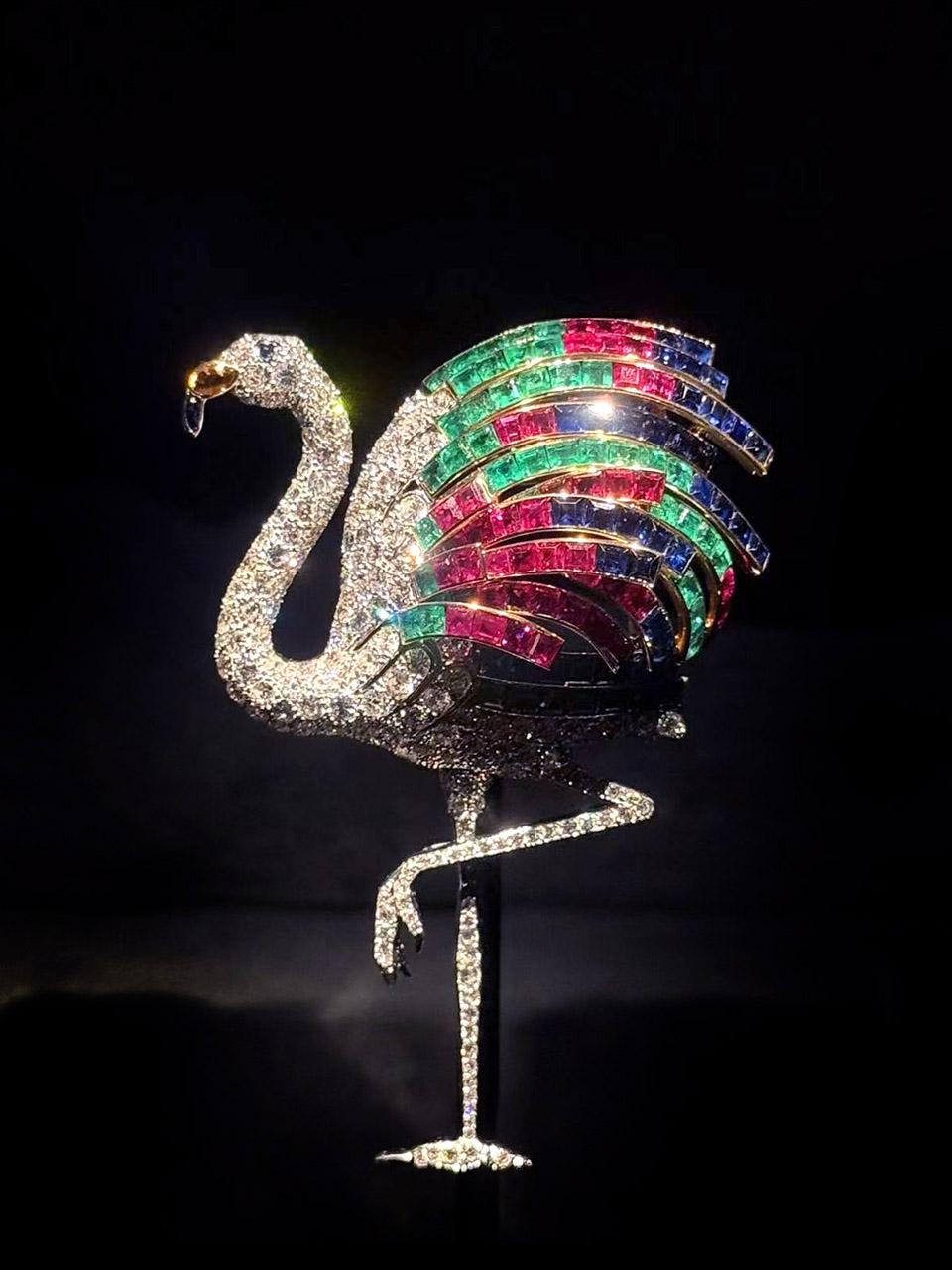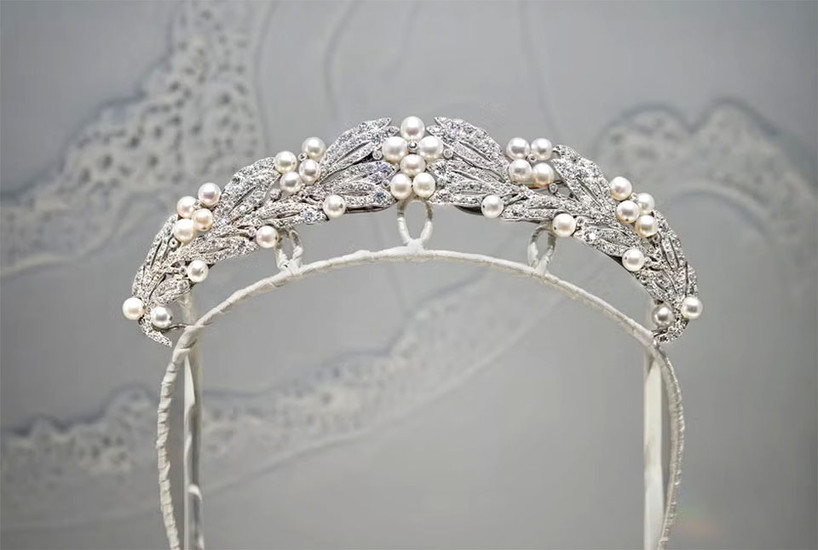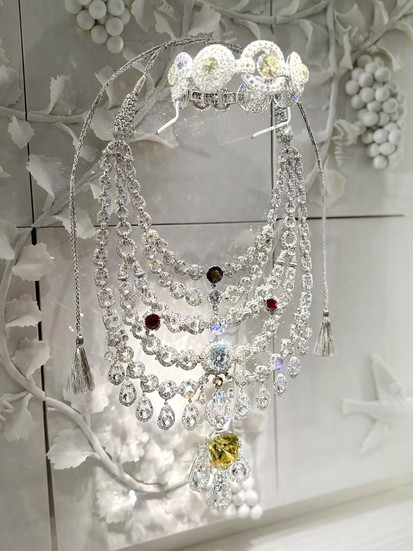By OGP Reporters / Members Contribute File Photos
Oh Good Party
Colored diamonds, in particular, have shown strong performance in recent years. For example, during the 2024 Sotheby’s Hong Kong auction, an 11.15-carat flawless fancy vivid yellow diamond ring sold for $9.8 million (approximately HKD 76.5 million), setting a new record for yellow diamonds in the Asian market. Similarly, a rare blue sapphire from Sri Lanka fetched $1.5 million, showcasing the allure of natural gemstones as investments. On November 29, Christie’s Hong Kong held an auction titled The Essence of Taiyi: The Jadeite Collection of Bluetian Studio, where 75 pieces of ancient jade sold for a total of HKD 215 million. These treasures, not only artistic masterpieces but also cultural artifacts, illustrate the enduring appeal of jadeite and ancient Chinese jade, which continue to attract global collectors for their rarity and cultural significance.
On November 4, 2024, Timeless Allure: The Magic of Cartier’s Artistry opened to great acclaim at the East Wing of the Shanghai Museum. This exhibition serves as a testament to the significance of Sino-French cultural exchange and offers a spectacular showcase of over a century of jewelry artistry. Featuring 332 exquisite pieces from the Cartier Collection alongside Chinese cultural relics, the event creates a profound dialogue between art and culture. Through this lens, we can trace the historical trajectory of jewelry, appreciate its artistic allure, and delve into its value in collection and investment.
The History of Jewelry: Witness to a Radiant Legacy
As an enduring companion of human civilization, jewelry has symbolized identity, power, and wealth for millennia. From the gold adornments of ancient Egypt to the gem-studded crowns of the Han Dynasty, jewelry has transcended its role as personal decoration to become a cultural emblem.
Crowns, as the centerpiece of European royal jewelry, symbolize power, prestige, and divine duty. At the turn of the 19th century, Cartier pioneered the use of platinum in crown-making. This innovative material, both lightweight and durable, enhanced the brilliance of diamonds, allowing them to radiate unmatched purity. This breakthrough cemented Cartier’s reputation as the “Jeweler of Kings.”
For instance, the diamond crown designed by Cartier for the coronation of King Edward VII embodies the streamlined geometric designs and meticulous craftsmanship characteristic of the Art Deco movement. Queen Mary’s tiara, in contrast, incorporates emeralds and pearls, symbolizing wisdom and prosperity. Beyond its role as an emblem of secular authority, the crown occupies a central position in religious rituals; in coronation ceremonies, its placement signifies the divine bestowal of royal power.
In contrast to the dazzling brilliance of European tiaras, which prioritize diamond cutting and optical effects, the crown ornaments of the Han Dynasty reflect a deep reverence for nature and cultural philosophy. A golden crown from this era, featuring motifs of olive branches, symbolizes eternity and peace. The gemstones embedded within, such as rubies and sapphires, likely originated from trade along the Silk Road, showcasing the prosperity of Han Dynasty commerce and the era's aesthetic sensibilities. Emphasizing harmony between humanity and nature, these designs often adorned emperors or nobles, signifying their role as guardians of cosmic order within a Confucian framework.
The juxtaposition of these Eastern and Western crowns illuminates not only their craftsmanship but also their reflection of cultural exchange. The Silk Road facilitated the introduction of gemstones and goldsmithing techniques to the Han Dynasty, while European aristocracy in the early 19th century began adopting floral motifs inspired by Eastern traditions. Such cross-cultural exchanges have provided boundless inspiration for modern jewelry designers. As vessels of human thought, belief, and identity, jewelry bears witness to the evolution of civilizations and the rich tapestry of cultural fusion.
The Art of Jewelry: A Collision of Craftsmanship and Innovation
Cartier, renowned for its exceptional craftsmanship and innovative designs, draws inspiration from nature, geometric art, and the fusion of diverse cultures. During the 1920s and 1930s, the Art Deco movement gained worldwide prominence, characterized by sleek geometric lines and symmetrical designs. Cartier emerged as one of its leading proponents.
A notable creation, the Tutti Frutti bracelet, was inspired by traditional Indian craftsmanship. It features rubies, sapphires, and emeralds carved into botanical and fruit-like shapes, accented with diamonds. This design masterfully blends the delicate elegance of the East with the modern geometric aesthetic of the West, establishing the collection as a hallmark of cultural dialogue and exotic allure in high jewelry.
Cartier also integrated Chinese traditional art into its designs. For example, the cigarette case inspired by Qing Dynasty lacquered furniture and the vanity case modeled after Han Dynasty bronze mirrors vividly illustrate the dialogue and fusion between Eastern and Western art. The “Qing Lacquered Furniture Cigarette Case” reinterprets intricate patterns from traditional Chinese lacquerwork using mother-of-pearl and gold, showcasing respect for and reinvention of Oriental artistry. The “Han Mirror Vanity Case,” inspired by the unique motifs of ancient Chinese bronze mirrors, incorporates mirror surfaces and gemstone inlays, harmonizing utility with artistry.
Nature’s vitality and imagery have always been central to Cartier’s jewelry designs, with its Animal Motif collection being particularly iconic. These works use a distinctive artistic language to express strength, elegance, and freedom. The exhibition highlights how Cartier has continuously explored exotic influences and advanced techniques to merge tradition with modernity. More than mere adornments, these pieces are cultural symbols and carriers of historical memory.
The Culture of Jewelry: A Reflection of Identity and Personality
Jewelry has always been more than decoration—it is a symbol of identity, culture, and individuality. Through its unique materials, designs, and historical narratives, jewelry embodies profound cultural significance, bearing witness to human artistry and history.
Cartier’s Caged Bird and Liberated Bird brooches, designed by Jeanne Toussaint, exemplify this. Crafted with lapis lazuli and diamonds in the colors of the French flag, they symbolize France’s oppression and liberation during World War II. These jewels transcend personal adornment, becoming cultural emblems of national history. Birds, a recurring theme in Cartier’s designs, are often depicted with diamonds, mother-of-pearl, and colored gemstones, capturing the beauty of nature while symbolizing freedom, dreams, and hope.
The double-crocodile necklace created for Mexican actress María Félix is a classic of Cartier’s animal-themed designs. Featuring crocodiles sculpted in gold, encrusted with yellow diamonds, emeralds, and rubies, the piece exudes lifelike realism. This necklace not only represents strength and power but also reflects the wearer’s independence and individuality. María Félix’s bold and unique taste added legendary allure to Cartier’s animal series.
Grace Kelly, Princess of Monaco, wore a ruby tiara that combined romance and elegance, embodying her noble status and personal charm. The Duchess of Windsor’s amethyst necklace, with its striking colors and bold design, showcased her audacious personality and flair for fashion. These jewels not only adorned the lives of their wearers but also became lasting symbols of their individuality.
Cartier’s Panther collection, introduced in the 1940s and led by Jeanne Toussaint, epitomizes feminine power, independence, and grace. Panther brooches, adorned with diamonds and featuring emerald eyes, portray the sleek elegance of the animal while symbolizing strength and sophistication. Adored by royalty and celebrities, the Duchess of Windsor’s panther jewels remain iconic to this day.
Cartier’s designs also embrace Chinese traditional elements. By blending jadeite and nephrite with Western craftsmanship, Cartier highlights the charm of cultural innovation. From ancient Chinese jade artifacts to modern haute jewelry, these creations transcend their material form, serving as witnesses to culture, emotion, and history. Through the centuries, jewelry has been a powerful symbol of identity, individuality, and the spirit of its era.
Jewelry Collecting and Investment: The Pursuit of Timeless Value
Jewelry collecting and investment have long been a significant part of the art market, with international brands like Cartier, Harry Winston, and Tiffany achieving record-breaking sales at auctions.
Colored diamonds, in particular, have shown strong performance in recent years. For example, during the 2024 Sotheby’s Hong Kong auction, an 11.15-carat flawless fancy vivid yellow diamond ring sold for $9.8 million (approximately HKD 76.5 million), setting a new record for yellow diamonds in the Asian market. Similarly, a rare blue sapphire from Sri Lanka fetched $1.5 million, showcasing the allure of natural gemstones as investments. On November 29, Christie’s Hong Kong held an auction titled The Essence of Taiyi: The Jadeite Collection of Bluetian Studio, where 75 pieces of ancient jade sold for a total of HKD 215 million. These treasures, not only artistic masterpieces but also cultural artifacts, illustrate the enduring appeal of jadeite and ancient Chinese jade, which continue to attract global collectors for their rarity and cultural significance.
Other notable artifacts, such as a jadeite belt buckle resembling ancient Chinese coins and clock screens styled after traditional Chinese furniture, demonstrate both artistic allure and cross-cultural significance. These items combine their intrinsic value with their historical and artistic significance, offering substantial investment potential.
Cross-Cultural Exchange and the Timeless Appeal of Jewelry
The exhibition The Infinite Beauty: Cartier's Magical Artistry juxtaposes Cartier’s century-long jewelry artistry with Chinese cultural relics, highlighting the profound interplay between Eastern and Western cultures. This dialogue extends beyond design language, with jewelry serving as a vessel for history and emotion, transforming it into timeless art. As French poet Jean Cocteau once said, “Cartier is a marvelous magician who, in a delightful way, captures fragments of the moon from rays of sunlight.” This poetic description encapsulates the unique charm of jewelry as a bridge between art and culture.
Throughout history, the stories of notable individuals and their jewelry have imbued these pieces with vivid significance. From Jean Cocteau’s custom-designed French Academy sword to Marilyn Monroe’s dazzling diamond necklace in Gentlemen Prefer Blondes and the Duchess of Windsor’s custom panther brooch, these pieces gain eternal brilliance through their connection to their owners.
Legendary Pieces and Their Stories
Elizabeth Taylor’s La Peregrina Pearl Necklace
Originally part of the Spanish royal collection, this extraordinary pearl was purchased by Richard Burton as a gift for Elizabeth Taylor, symbolizing their passionate love. Known for her extensive jewelry collection, Taylor elevated the allure of historical gems with her personal touch.
Barbara Hutton’s Jadeite Necklace
Sold for HKD 214 million at Sotheby’s in 2014, this necklace featured 27 perfectly matched imperial green jadeite beads, designed by Cartier. This masterpiece not only epitomized Hutton’s impeccable taste but also brought jadeite culture to global prominence.
Audrey Hepburn’s Tiffany Yellow Diamond Necklace
Worn in the film Breakfast at Tiffany's, this over-128-carat yellow diamond necklace became an enduring symbol of fashion and elegance, enhancing Hepburn’s timeless charm.
Grace Kelly’s Cartier Emerald-Cut Diamond Engagement Ring
Presented by Prince Rainier III of Monaco, this iconic piece remains a quintessential example of bridal jewelry. Its sophisticated design and romantic backstory continue to inspire modern love stories.
Diana, Princess of Wales’s Sapphire and Diamond Ring
Crafted by Garrard, the 12-carat oval sapphire surrounded by diamonds became a royal treasure. Passed down to Kate Middleton, it now serves as a bridge between generations of the British royal family.
The Maharajas' Creations by Cartier
Indian royalty commissioned Cartier to design stunning pieces like the Patiala Necklace, blending India’s opulent aesthetic with Western craftsmanship. These jewels stand as paragons of cross-cultural design.
Jewelry is more than a collection of luxurious materials; it embodies history, emotion, and artistry. These stories, intertwined with remarkable figures and extraordinary creations, illuminate the enduring brilliance of jewelry as a symbol of human culture and aspiration. In their timeless glow, we find reflections of dreams, identities, and legacies that transcend time. This exhibition, by showcasing a dialogue between a century of Cartier's jewelry artistry and Chinese artifacts, profoundly illustrates the fusion and innovation of Eastern and Western cultures. It is not only a visual feast but also an inspiring journey of cultural and artistic exploration. Running until February 17 of next year, this event is an unmissable opportunity for those passionate about jewelry artistry, history, and collection to experience the unique charm and cultural significance of fine jewelry.






























Comments